By Paul Blay April 5, 2021

So let’s assume we’re using OKRs now. We’ve come up with some Objectives and tried to find meaningful measures for our Key Results that we think will help us ensure we’re going in the right direction.
It’s important to remind ourselves that OKRs are just a tool. Using an ORK framework doesn’t necessarily ensure that we’re getting any tangible benefits over any other approach.
For example, the next two OKR examples for our imaginary TownTalk ™ product both provide an objective and measurable KRs against it, but do both really unlock the same value?
OKR 1
Objective: Deliver against the TownTalk Product Requirements Document
KRs:
- Go from 0 to 100 mandatory features complete
- Go from 0 to 20 desired features complete
- Package is released through Cognidox
OKR 2
Objective: TownTalk makes highstreets more vibrant and social than they have ever been, so that businesses and people are healthier.
KRs:
- TownTalk users highstreet visits go from 1 to 10 per month
- TownTalk users increase from 100 to 1000
- TownTalk users report a ‘community interaction’ score of over 8/10
I hope it’s pretty clear that OKR 1 has a lot to be desired (and if it doesn’t make you want to keel over with boredom, I don’t know what will). So much so that one might wonder what value an OKR framework really brings.
However, I have observed many more OKR 1 style OKRs in my career than OKR 2 style. I suspect there are many reasons for this, but one of the most compelling might be just about how much effort needs to go into the OKR creation in the first place. I created both of these OKRs just from the top of my head and I can honestly say that OKR 1 took me about 2 minutes to create whereas OKR 2 took about 20 minutes with several refinements – and that was without the constraints of reality or any consideration/agreement around other contributors ideas.
If OKRs are not treated as first class citizens, or being given the priority, time and focus required to develop and review them, they can easily become misused and stop providing the benefits you’re looking for.
Does this all mean that OKR 1 is of zero value? Do all OKR attempts fall into categories of “bad” or “good”?
I’d suggest not. There are several ways in which OKRs can provide value, and the more of those ways are enabled, the better. Having said that, sometimes we’re constrained by what we can measure, or we’re on a journey as a company and don’t want to overwhelm teams with a sudden, drastic change.
Wouldn’t it be nice if we had some sort of scoring mechanism for how “mature” an OKR is?
Put your OKRs on a maturity scale
While I was running an OKRs CoP at work, we identified that being able to ‘score’ OKRs on a scale would allow us to try and make ours better over time. There didn’t seem to be anything on the internet that provided what we wanted, so I came up with something the group could review and refine.
This is how it works:
Objective Scoring
Out of ten, score:
- Is inspiring to me
- Represents an important impact in the world
- I understand why
Then apply multipliers:
- Represents value for the business
- No Value (0)
- Indirect Monetary Value (1)
- Direct Monetary Value (2)
- Defines
- What (0)
- How (0)
- Where (1)
Key Result Scoring
Out of ten, score:
- Is “realised” as opposed to “delivered”
- I would consider reaching this as a significant aspect of the objective complete
Then apply multipliers:
- Is numerical: Yes (2), No (1)
- Measurability: Is measurable now (2), Could be measured with some work (1), Cannot be measured directly (0)
- Represents a change in customer behaviour: Yes (2), No (1)
- Distribution over OKR lifetime:
- Even distribution (2)
- Front/back loaded (0.5)
- Single event / after lifetime (0)
- Multiple paths to achievement: Yes (1), No (0)
Worked Example
I’ll run through the application of the scorecard across the two OKR examples.
OKR 1
Objective: Deliver against the TownTalk Product Requirements Document
- Inspiration: 0/10
- Impact: 1/10
- Understand why: 0/10
- Monetary Value: Direct (2)
- Defines: Where (1)
Total Objective score: 2/60
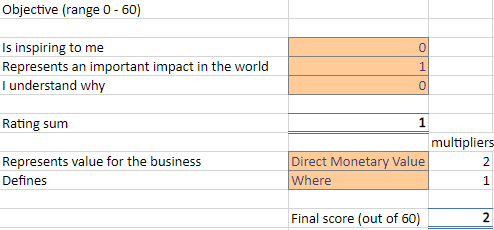
Key Results:
- Go from 0 to 100 mandatory features complete
- Go from 0 to 20 desired features complete
- Package is released through Cognidox
Outcome: These are mostly delivered not realised, numerical yes, measurable yes, but zero multiplier on multiple paths => poor scores.
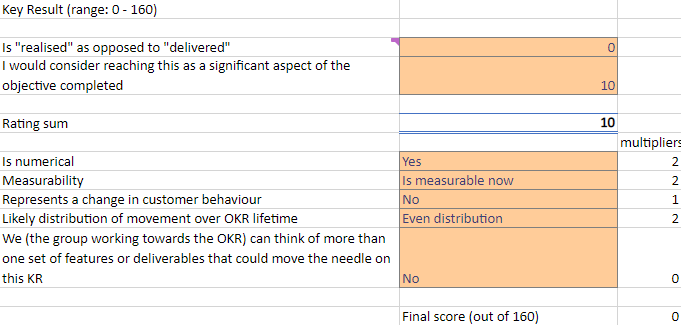
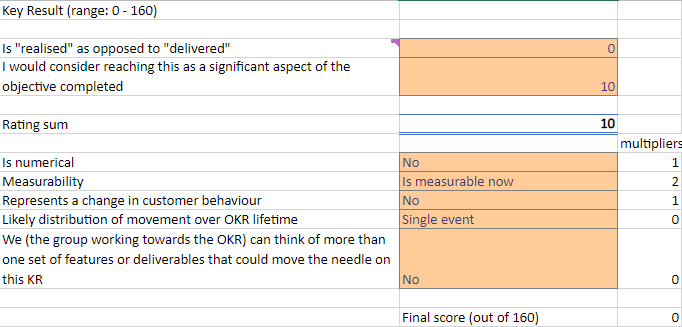
OKR 2
Objective: TownTalk makes highstreets more vibrant and social than ever before.
- Inspiration: high
- Impact: 7/10
- Understand why: 9/10
- Monetary Value: Direct
- Defines: Where
Total Objective score: 48/60
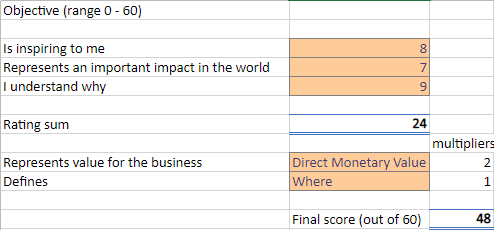
Key Results and their scores:
- Highstreet visits from 1 to 10/month: 144/160
- Users from 100 to 1000: 96/160
- Community interaction score 8/10: 80/160
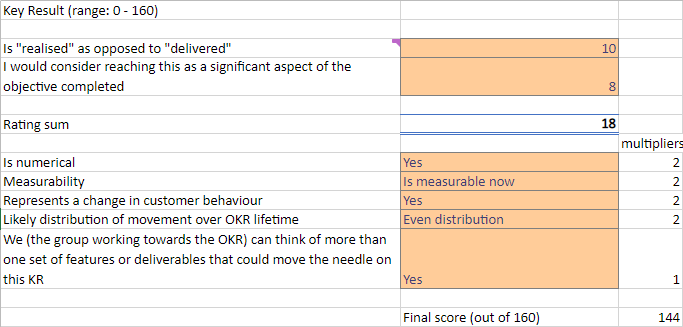
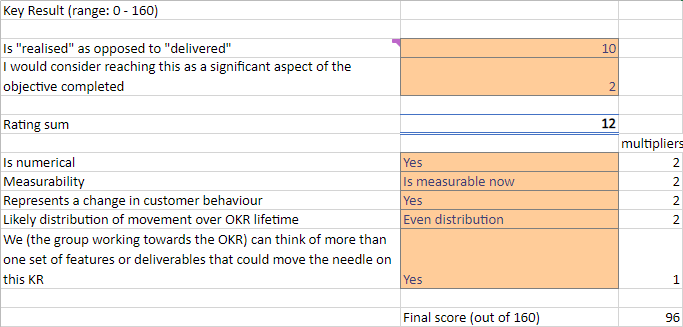
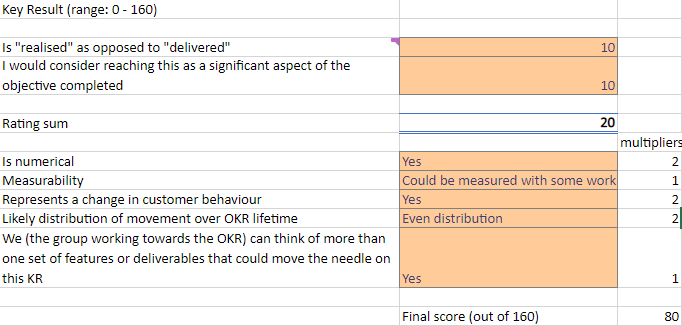
Improvements moving forward
This is my first attempt at an OKR scorecard and I hope there’s some value in the idea. Some thoughts for improvement:
- Should monetary value be removed from objective scoring?
- Combined KRs could be scored as a group to check if something fundamental is missing.
- Qualify each question to a specific OKR benefit (empowerment, alignment, progress, value-focus).
- Review why multipliers exist — maybe too harsh.
The Sheet
Here’s the scorecard sheet if you’d like to try your own scoring:
Download the OKR Scorecard (Excel)
Thanks for reading!